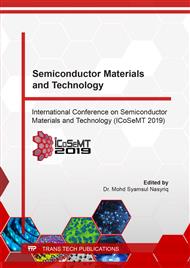p.18
p.27
p.35
p.43
p.52
p.60
p.69
p.77
p.87
UV_Blue Light Conversion Using Dyes Polymeric Materials
Abstract:
White light-emitting diode (LED) is used in a new generation of solid-state lighting due to its advantages in energy saving and environmental friendliness. Based on this assumption, Emphasis was put on trying to establish a laboratory technique to convert UV-blue light into white light by using polymeric materials. In this work, an laboratory technique to convert UV-blue light into white light by using polymeric materials, consisting of red (R), green (G) and blue (B) for a white light generation. The project employed the use Colouring polymorph plastic as an active materials mixed with Silicone Sealant in different ratio and pumping by UV-Blue light. Colour rendering index (CRI) and correlated colour temperature (CCT) as main measurement parameters to evaluate the performance of the white light. The best white light appearance an indicated by photo and colour meter were achieved by mixing red (R), 0.05gm and green (G), 0.1gm the optimum results were CCT =3606k, CRI =70.3, x=0.3661, y=0.2925, and by mixing red (R), 0.005gm and green (G), 0.005gm the results were CCT=4891 k, CRI =63.8 and x=0.3359, y=0.2405.
Info:
Periodical:
Pages:
52-59
Citation:
Online since:
March 2020
Authors:
Keywords:
Price:
Сopyright:
© 2020 Trans Tech Publications Ltd. All Rights Reserved
Share:
Citation:


